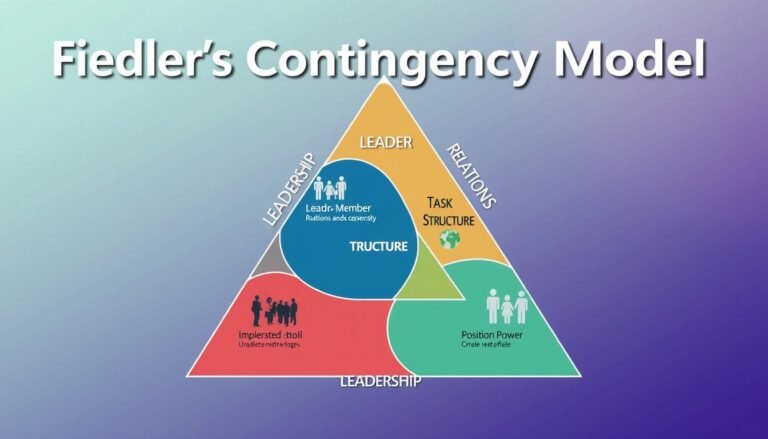Theory X and Theory Y: Management Styles Explained
Ever thought about how a manager’s beliefs affect an entire company? The difference between Theory X and Theory Y shows how management styles change employee motivation and the whole company’s behavior. Douglas McGregor introduced these theories in the 1960s. They show how leaders can either make a team work well together or create a place of fear.
Theory X says people don’t like working and need to be forced to do their best. Theory Y believes people want to take on responsibility and work hard if given the chance. This idea changes how managers lead and affects the company’s culture and success.
We’ll look into where these theories came from, what they’re about, and how they work in real life. This will help us see how knowing about them can make employees happier and work better.
Key Takeaways
- Theory X and Theory Y were developed by Douglas McGregor to describe opposing management styles.
- Leaders often align with either Theory X, which relies on control, or Theory Y, which emphasizes empowerment.
- Implementing Theory Y leads to high employee motivation and commitment.
- Finding a balance between Theory X and Theory Y is essential for most organizations.
- Effective management requires understanding the intrinsic motivations of employees.
A Brief Overview of Management Theories
Understanding management theories is key to being a good leader and making a company successful. These theories help us see how different management styles affect workers and the company’s behavior. Theory X and Theory Y are two main theories that show how to manage people in different ways.
Understanding Management Theories
Management theories offer various ways for managers to work with their teams. The Classical Management Theory focuses on being efficient and organized. The Behavioral Management Theory looks at what motivates employees and how they work together.
Douglas McGregor’s Theory X and Theory Y show how managers see their employees. Theory X believes employees are lazy and need close watching. Theory Y says people can motivate themselves and be creative if given the chance.
The Impact of Management Theories on Organizations
Management theories have a big effect on how companies behave. Companies that use Theory X management often use strict methods. They focus on basic needs like food and safety, which can make employees unhappy. They don’t get to work on their deeper needs.
On the other hand, companies that use Theory Y do better. They give employees more control and tasks, which makes them more motivated and productive.
The Importance of Employee Motivation in Contemporary Workplaces
In today’s fast-paced work world, keeping employees motivated is crucial for success. Management theories teach us to match what employees want with what the company aims for. Things like making decisions together and giving feedback can boost innovation and happiness at work.
Using a management style like Theory Y can create a workplace where creativity and hard work are valued. This leads to a company doing well.
| Management Theory | Assumptions | Approaches | Impacts on Motivation |
|---|---|---|---|
| Theory X | Employees dislike work and avoid it | Close supervision, coercive methods | Focus on physiological and safety needs |
| Theory Y | Work is natural and fulfilling | Decentralization, participative management | Enhancement of creativity and self-direction |
| Behavioral Management Theory | Understanding motivations enhances productivity | Group dynamics and social needs | Higher job satisfaction and engagement |
| Scientific Management Theory | Work can be optimized through processes | Standardized work practices, training | Improved efficiency through task specialization |
The Origins of Theory X and Theory Y
In the 1960s, Douglas McGregor changed how we think about work and management. He looked into what motivates employees and how managers should lead. His ideas were new and still important today.
Douglas McGregor: The Architect of Motivation Theory
Douglas McGregor’s ideas changed the way we see management. He focused on what drives employees. He came up with Theory X and Theory Y to show how managers see their workers.
He showed that how managers act affects the workplace and how engaged employees are.
The Publication of “The Human Side of Enterprise”
His big book, “The Human Side of Enterprise,” came out in 1960. It talked about Theory X and Theory Y. Theory X says people are lazy and need close watching. Theory Y believes workers are motivated and enjoy their jobs.
This book is still key in teaching management today.
Separation of Management Approaches into Two Models
McGregor’s ideas help leaders pick the right way to manage. By choosing between Theory X and Theory Y, leaders can make their teams happier and more productive. Using Theory Y means sharing decisions and letting everyone have a say.
This approach boosts motivation and satisfaction at work. McGregor’s work reminds us that how leaders act shapes the whole company.
Diving Deep Into Theory X and Theory Y
Understanding the differences between Theory X and Theory Y gives us insights into what motivates employees and how leaders manage them. These theories show us how leaders see their workers and affect their engagement at work.
Defining Theory X: Assumptions and Characteristics
Theory X assumes that people naturally dislike work. This leads to leaders controlling their teams too much. They see about 20% of employees as lazy or not ambitious. This style of leadership uses rewards and threats to keep people in line, focusing on following rules rather than being engaged.
Exploring Theory Y: Attributes and Beliefs
Theory Y looks more positively at people. It says employees like their work and can manage themselves. About 70% of workers are seen as self-motivated, creating a trust-based, collaborative work environment. Companies using Theory Y see a 25% jump in employee engagement and a 15% boost in performance. This approach fits well with Gen Z, who do best in places that value freedom, responsibility, and learning.
| Aspect | Theory X | Theory Y |
|---|---|---|
| View of Employees | Inherently dislike work, need control | Inherently enjoy work, seek self-direction |
| Management Style | Authoritarian, micromanagement | Participative, empowering |
| Employee Motivation | Extrinsic rewards, punishment | Intrinsic motivation, meaningful work |
| Workplace Culture | Compliance-focused | Trust and collaboration |
| Employee Performance | Lower morale, high turnover | Higher engagement, better relationships |
The Impact of Theory X and Theory Y on Organizational Behavior
Management styles based on Theory X and Theory Y deeply affect workplace culture and behavior. These theories show how different management styles change how employees work together and how engaged they are.
How Management Styles Shape Workplace Culture
The way Theory X and Theory Y interact shapes the workplace culture. Theory X leads to a strict, rule-heavy work environment. This can make employees unhappy and lead to them leaving. On the other hand, Theory Y creates a trusting, collaborative culture. This boosts job happiness and improves work performance.
Real-World Examples and Case Studies
Many companies have seen the effects of Theory X and Theory Y in their actions. For example, Coca-Cola changed from a Theory X to a Theory Y approach. This led to happier employees and better work output. By valuing open communication and creativity, Coca-Cola became a leader in keeping employees engaged.
The Role of Leadership Styles in Employee Engagement
Leadership styles greatly affect how Theory X and Theory Y work in a company. Theory Y leaders encourage sharing ideas and taking the lead. Theory X leaders might see their teams not caring, which hurts the company’s goals. Good leaders know how to keep employees involved without losing focus on work.
| Characteristic | Theory X | Theory Y |
|---|---|---|
| Employee Motivation | Extrinsic (coercion, punishment) | Intrinsic (self-drive, creativity) |
| Management Approach | Directive, controlling | Collaborative, supportive |
| Workplace Culture | Rigid, demotivating | Trusting, engaging |
| Impact on Performance | Potential for high turnover | Enhanced employee satisfaction |
Conclusion
Understanding Theory X and Theory Y is key to better management and motivating employees today. Douglas McGregor introduced these theories in the 1960s. They challenge old ideas about what motivates workers.
Theory X says workers are lazy and need close watching. Theory Y believes employees do well with freedom and trust. This approach can lead to more engaged workers, better performance, and a positive work environment.
Using Theory Y can also mean lower turnover and higher productivity. This is important in today’s fast-paced work world. Companies that use Theory Y keep good employees and adapt to changing work needs.
Managers can use both Theory X and Theory Y to lead effectively. Focusing on teamwork and trust, especially in creative jobs, makes the most of people’s skills. This approach helps companies succeed over time. As we go forward, using these ideas will help keep workers motivated and engaged.
Source Links
- Theory X and Theory Y (& Z): Employee Motivation Explained
- Theory X and Theory Y
- A look at McGregor’s X and Y Theory of Management
- Reading: McGregor’s Theory X and Theory Y
- Overview of Management Theories | Classical, Behavioral, Modern
- McGregor’s Theory X and Theory Y – MBANote
- McGregor’s Theory X Theory Y | MTD Training
- Theory X and Theory Y
- McGregor’s Theory X and Theory Y
- The Modern-day Relevancy Of Theory X and Theory Y – Blog
- Leadership: Theory X vs. Theory Y Attitudes — The Encompass Group
- McGregor’s Motives Meet Gen Z: Can Theory X and Y Bridge the Gap?
- McGregor’s Theory X/Y and Job Performance: A Multilevel, Multi-source Analysis
- Microsoft Word – 5-The Evolution of McGregor’s X and Y Theory in the Contemporary Organizational Settings
- McGregor Theory Of Motivation- Theory X & Theory Y Explained
- McGregor’s Theory X and Theory Y explained | Management 3.0
- Theory X and Theory Y by Douglas McGregor explained







